
PROGRAM NOTES
Persian Classical Music
Listen Now
download
Subscribe (itunes)
Subscribe (rss)
help
Program
Persian Classical Music
Kayhan Kalhor, kamanche
Behrouz Jamali, tombak
| Song (Artist) | Track |
|---|---|
| Dastgāh-e Rāst-panjgāh | 0:00–20:45 |
| Āvāz-e Afshāri | 20:45–30:20 |
| Dastah Segāh | 30:20–59:20 |
| Dastgāh-e Rāst-panjgāh | 59:20–70:30 |
The performance begins in the melodic mode (dastgāh) of rāst-panjgāh, a type of scale primarily used in classical music, with few examples of its use in popular genres. The rāst in the name means “straight” or “right,” and the scale of this mode is very close to that of the major diatonic scale in Western classical music. This is followed by āvāz-e afshāri, a constituent mode of the umbrella mode of shur, the most important of the Persian modes. Shur is noted for its tragic and somber character. The name of the mode literally means “emotion.” It is similar in structure to the natural minor scale in Western music. Some Iranian musicians place this mode above all others in importance, saying that if only one mode could be kept in Persian classical music, this would it. The segment of this mode accompanied by tombak (drum) uses a five-beat meter. Following afshār is the mode known as segāh, one that is often difficult for Westerners to appreciate, due to its use of five half-flatted tones (notes pitched between natural and flatted notes in the Western diatonic system). The concert concludes by returning to brighter mood of rāst-panjgāh where it began.
- Notes on Persian modes adapted from Jean During et al. (1991) and Ella Zonis (1973). (See under “Notes on the Program” for full citations.)
This concert was made possible through support from the Thaw Charitable Trust and was presented in conjunction with Silk Road Luxuries from China. Audio preservation and editing of this recording were supported by funds from the Smithsonian Women’s Committee.
Listen Now
download
Subscribe (itunes)
Subscribe (rss)
help
Notes
The Kamanche and the Silk Road
The Persian fiddle (kamanche) originated in Central Asia. Its popularity spread east and west along the caravan trails and trade routes of the Silk Road. In the Arab world the earliest reference to such an instrument is found in a tenth-century musical treatise by the scholar al-Farabi. The term kamanche first appears in Persian literature in a twelfth-century poem by Masud Sad Salman. In China, literary references to bowed lutes played by nomadic tribes date to the Song dynasty (960–1279). The Freer and Sackler collections include several sixteenth-century Persian paintings depicting the kamanche being performed for Bahram Gur, a king in the fifth century.
Persian Classical Music
The repertoire of Persian classical music is known as the radif, which musicologist Bruno Nettl has called “the principal emblem and the heart of Persian music, a form of art as quintessentially Persian as that nation’s fine carpets and exquisite miniatures.” The radif includes approximately four hundred individual pieces, each called a gusheh, that are divided into twelve groups, or dastgah. A performance from the radif begins with an introduction, which presents the melodic mode of the particular dastgah chosen by the artist. After the introduction, the soloist performs various pieces from that dastgah, often modulating from the mode of the introduction to other modes. A cadential motif might link one gusheh to the next, thus bringing the listener’s attention back to the basic mode of the dastgah. A modern performance usually features a selection of the more outstanding pieces from the group, since playing all the pieces in any one dastagh requires more time than modern audiences are accustomed to hearing.
The artist’s process of selecting which pieces to perform, and in what order, is part of the improvisatory nature of Persian music, but more important is the musician’s interpretation of each gusheh. The performer alters and embellishes the gusheh at will and presents it in a different way each time. Responding to their feelings at the moment, musicians can create highly personal and intimate renditions of each gusheh by varying and adding to it.
The ideal state of mind for this improvisation is one of total immersion, as if the musician is possessed by the essence of the mode or rhythmic cycle and loses any sense of being a voluntary participant in the event. When improvisation reaches its height, the performance can become unpredictable even to the musician. From this experience comes the idea that music originates from an outer source, and the performer, through virtuosity, is a mere vehicle.
Notes on Persian music and instruments were adapted by Michael Wilpers from Jean During et al., The Art of Persian Music (Mage 1991), Hormoz Farhat, “Iran,” in S. Sadie, ed., New Grove Dictionary of Music and Musicians (Macmillan 1980); Ella Zonis, Classical Persian Music (Harvard 1973); and Terrence Liu, “Instruments: Erhu,” in R. Provine et al., Garland Encyclopedia of World Music, volume 7, “East Asia: China, Japan, and Korea” (Garland 2002).
Listen Now
download
Subscribe (itunes)
Subscribe (rss)
help
Performers
Kayhan Kalhor
Kayhan Kalhor, kamamche, is an internationally acclaimed virtuoso on the kamanche (Persian spike fiddle). His performances of Persian music and his many collaborations have attracted audiences around the globe. Born in Tehran, he began his musical studies at the age of seven. At thirteen, he was invited to work with the National Orchestra of Radio and Television of Iran, where he performed for five years. When he was seventeen, he began performing with the Shayda Ensemble of the Chavosh Cultural Center, the most prestigious arts organization in Iran at the time. He has traveled extensively throughout Iran, studying the music of its many regions, in particular that of Khorasan and Kordestan.
Kalhor has toured the world as a soloist with the New York Philharmonic, the Orchestre National de Lyon, and Yo-Yo Ma’s Silk Road Ensemble. He is cofounder of Dastan; Ghazal: Persian and Indian Improvisations; and Masters of Persian Music. In addition, he has composed works for Iran’s most-renowned vocalists, Mohammad Reza Shajarian and Shahram Nazeri, and he has performed and recorded with Iran’s greatest instrumentalists.
A composer of music for television and film, Kalhor was recently featured on the soundtrack of Francis Ford Copolla’s Youth Without Youth, and he collaborated on a score with Osvaldo Golijov. In 2004 American composer John Adams invited Kalhor to give a solo recital at Carnegie Hall as part of its Perspectives series. That same year Kalhor appeared on a double bill at Lincoln Center’s Mostly Mozart Festival.
Kalhor’s compositions Blue as the Turquoise Night of Neyshabur, Silent City, and Mountains Are Far Away appear on the three recordings of the Silk Road Ensemble, of which he is an original member. His recent commission, for the Kölner Philharmonic in Germany, premiered in 2009.
Three of his recent recordings have been nominated for Grammy Awards: Faryad, Without You, and The Rain. His CD Silent City (with Brooklyn Rider) was released on the World Village label in 2008 to critical acclaim.
Behrouz Jamali
Behrouz Jamali, tombak, was born into a family of scientists and artists in Tabriz, Iran. His music activities started at a young age after his family moved to England; he studied recorder and performed at Durham Cathedral. Upon his return to Iran, he studied Persian classical music in Tabriz with Mohammad Akhavan (tombak) and Behrouz Afshari (violin) and Western classical music with Zaven Yedigarian (violin), among others.
While in high school, Jamali earned a tombak instructor’s permit from the Ministry of Culture and began teaching with Ali Salimi, a composer and master of Azerbaijani tar (lute). This rich musical environment led to concerts as a performer, composer, and music director. His compositions include works for solo instruments, chamber music ensembles, and electronic music. Jamali also became interested in studying Persian calligraphy.
Jamali graduated with a bachelor’s degree in civil engineering and studied acting and composing for theater. Since moving to the United States, he has conducted master classes on Persian classical music at the Juilliard School, Boise State University, and Middlebury College. He has accompanied Kayhan Kalhor at Yale University, Carnegie Hall, the Museum of Fine Arts, Boston, Symphony Space (New York), and for the World Music Institute. He also performed a live broadcast on WNYC.
Listen Now
download
Subscribe (itunes)
Subscribe (rss)
help
Related Images

Kayhan Kalhor performs on the Persian fiddle (kamanche), accompanied by Behrouz Jamali on tombak, at the Freer Gallery of Art on March 17, 2012. This type of fiddle probably originated among the tribal horsemen of Central Asia. As its use spread east and west along the Silk Road, the instrument developed into the kamanche of Persia, the rabab of the Arab world, the er-hu of China, and the kyoku of Japan.
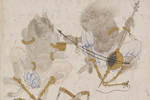
The spike fiddle makes a bold appearance in this fifteenth-century image from Iran or Central Asia. The demon on the right plays a fiddle while the other one holds a Chinese blue-and-white porcelain bottle. The composition shows the impact of trade between China and Central Asia along the so-called Silk Roads, which had a profound impact on music and the visual arts.
Detail, Two fettered demons. Iran or Central Asia, Timurid period, 15th century. Ink, opaque watercolor, and gold on paper. Purchase, F1937.25
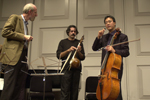
Kayhan Kalhor (center) has appeared three previous times on the stage of the Meyer Auditorium. Twice he performed as part of Yo-Yo Ma’s Silk Road Ensemble. During a “musical conversation” at the Freer in 2001 (above), Kayhan discusses the ensemble’s work with ethnomusicologist Ted Levin (left) and cellist Yo-Yo Ma. The ensemble included musicians and composers from China, India, Mongolia, Iran, and Turkey, as well as instrumentalists trained in the Western classical tradition.
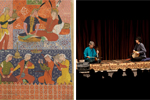
This sixteenth-century painting features a kamanche player and percussionist as part of a quartet entertaining the fifth-century king Bahram Gur and his princess. They perform in his Red Pavilion, one of several structures that were known for their unified color schemes. According to some paintings, each colored house had its own unique musical ensemble. At right, Kayhan Kalhor and Behrouz Jamali perform at the Freer Gallery in 2012.
Detail, Bahram Gur and the Princess in the Red Pavilion, from the Khamsa (Quintet) by Nizami (d. 1209). Iran, Astarabad, Safavid period, ca. 1560. Opaque watercolor, ink, and gold on paper. Purchase—Smithsonian Unrestricted Trust Funds, Smithsonian Collections Acquisition Program, and Dr. Arthur M. Sackler, S1986.283

Kamanche players performed in outdoor scenes as well. In this sixteenth-century painting, an ensemble of musicians playing lute, fiddle, percussion, panpipe, and end-blown flute accompanies two dancers in celebrating the arrival of Zulaykha (Potiphar’s wife) to Egypt. The story of Yusuf (Joseph) and Zulaykha is found in the Bible, the Koran, and popular Persian classical literature.
Detail, Aziz and Zulaykha enter the capital of Egypt and the Egyptians come out to greet them. Folio from a Haft awrang (Seven thrones) by Jami (d. 1492). Iran, Khurasan, probably Mashhad, Safavid period, 1556–65. Opaque watercolor, ink, and gold on paper. Purchase, F1946.12.100
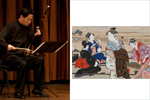
Traveling along the Silk Road, the fiddle reached China by the twelfth century, where it took the form of the er-hu, played here by Wang Guowei at the Freer. In Japan, it became known as the kokyu and was a fixture in entertainment music starting in the seventeenth century. This image from Edo-period Japan shows three geisha playing kokyu, shamisen, and koto in an elite pleasure house located in a suburb of Edo (modern-day Tokyo).
Detail, Moonlight Revelry at Dozo Sagami. Kitagawa Utamaro (1753–1806). Japan, Edo period, late 18th–early 19th century. Hanging scroll; ink and color on paper. Gift of Charles Lang Freer, F1903.54
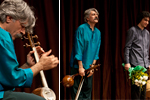
Kayhan Kalhor uses a plucking technique in performing on the traditionally bowed instrument. He and Behrouz Jamali take a bow following their performance at the Freer Gallery on March 17, 2012.
Listen Now
download
Subscribe (itunes)
Subscribe (rss)
help
The Credits
This concert and podcast was made possible through support from the Thaw Charitable Trust and was presented in conjunction with Silk Road Luxuries from China. Audio preservation and editing of this recording were supported by funds from the Smithsonian Women’s Committee.
Podcast, notes, and slideshow were coordinated by Michael Wilpers, Manager of Public Programs.
Thanks to Andy Finch for audio recording, Neil Greentree for photography, SuMo Productions for audio editing, Torie Castiello Ketcham for podcast design, Nancy Eickel for text editing, Massumeh Farhad for curatorial review, Cory Grace and Betsy Kohut for artwork images, and especially the artists for permission to podcast their performance at the Freer Gallery.
Podcast Series
Concerts
Storytelling
Lectures
Subscribe to this Series
 RSS
RSS iTunes
iTunes
About Podcasts
About podcasting and how to get started
![]() Tell us what you think
Tell us what you think
Radio Asia
Explore music from all across Asia with Radio Asia, a stream of complete tracks from the collections of Smithsonian Global Sound
Most Recent Podcasts
Musicians from Marlboro IMusic of Toru Takemitsu and Tan Dun: Ralph Van Raat, piano
The Legacy of Yatsuhashi
The Traveler’s Ear: Scenes from Music
Western Music in Meiji Japan: Gilles Vonsattel, piano
Western Music in Meiji Japan
The Art of Afghan Music
Painting with Music: Bell Yung, qin
Sounds from Arabia
Tarek Yamani Trio